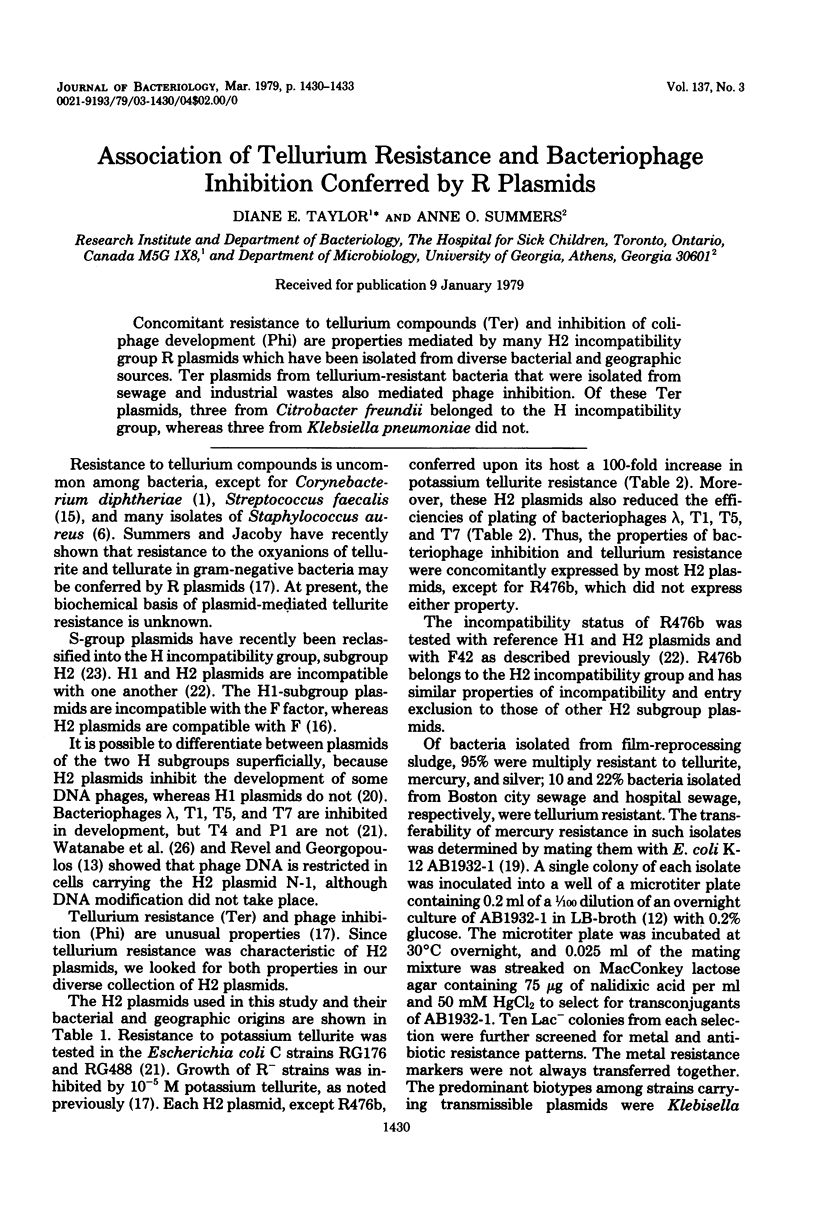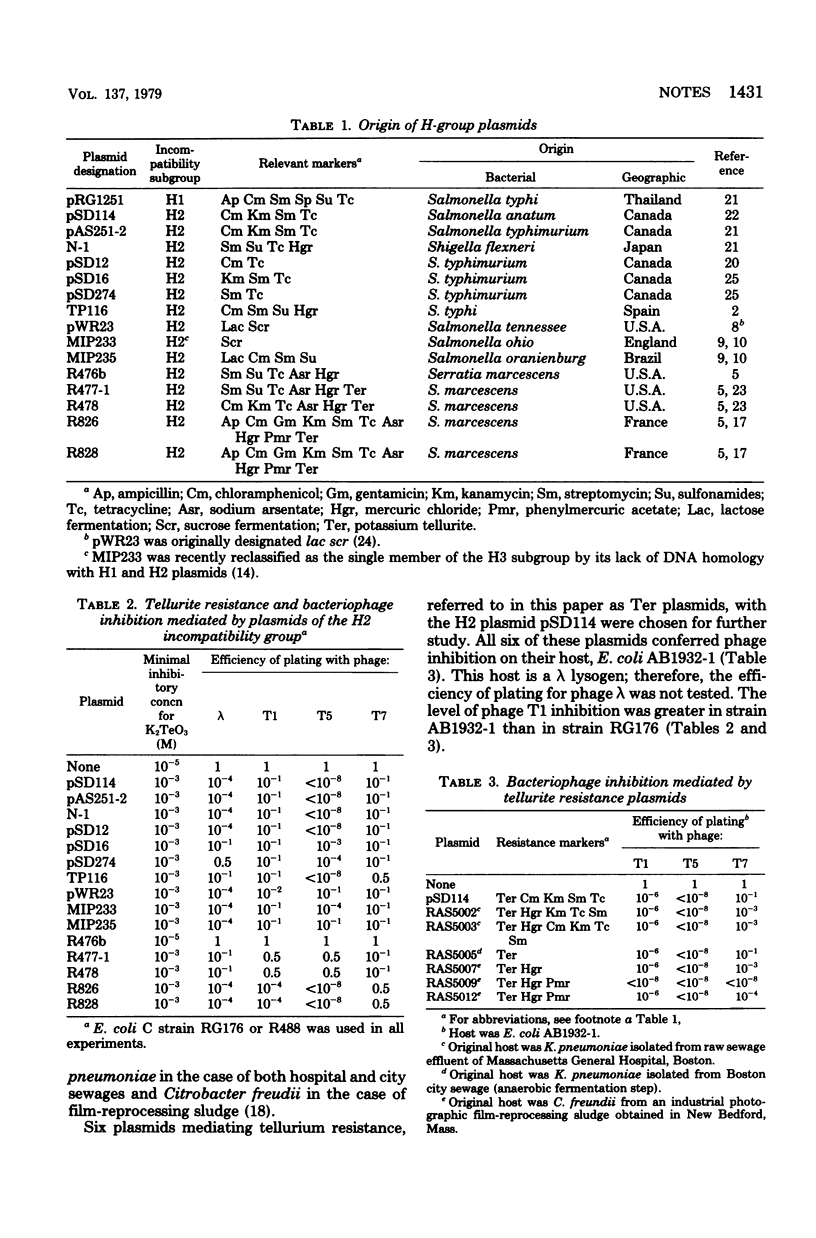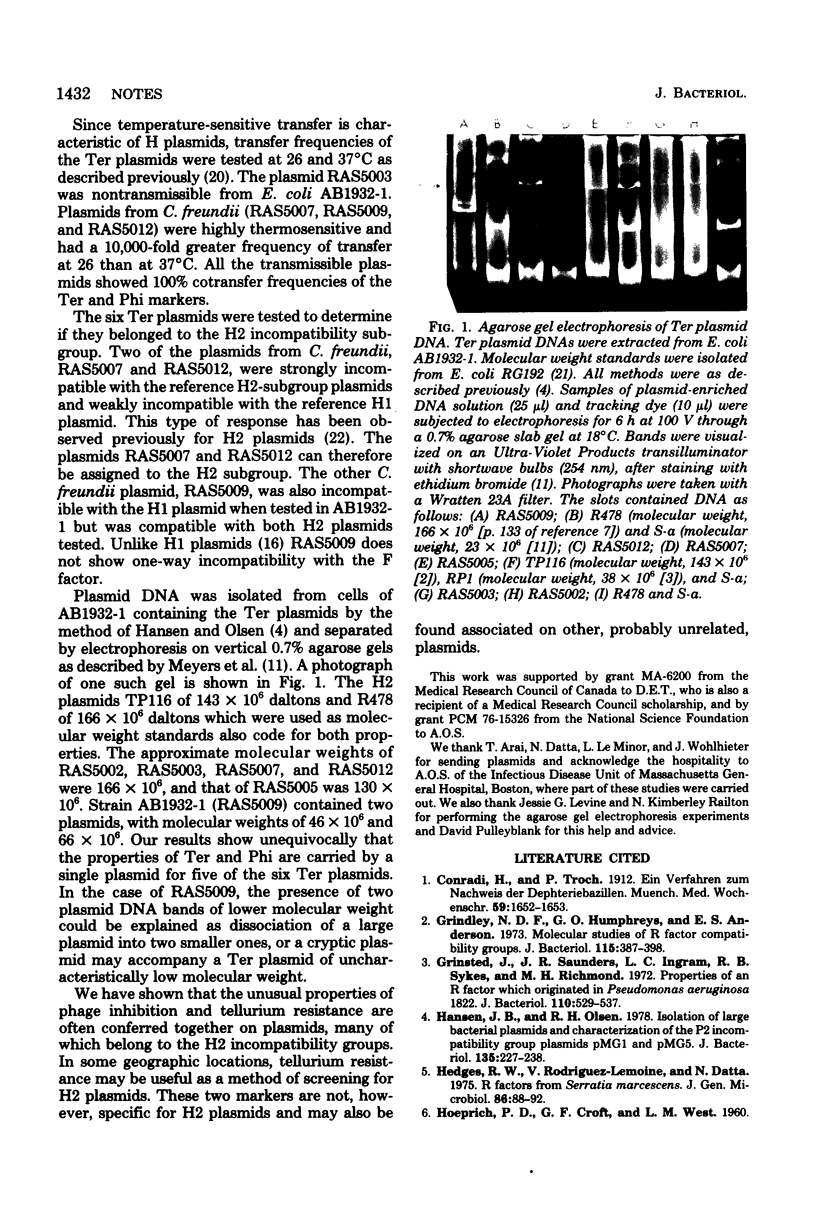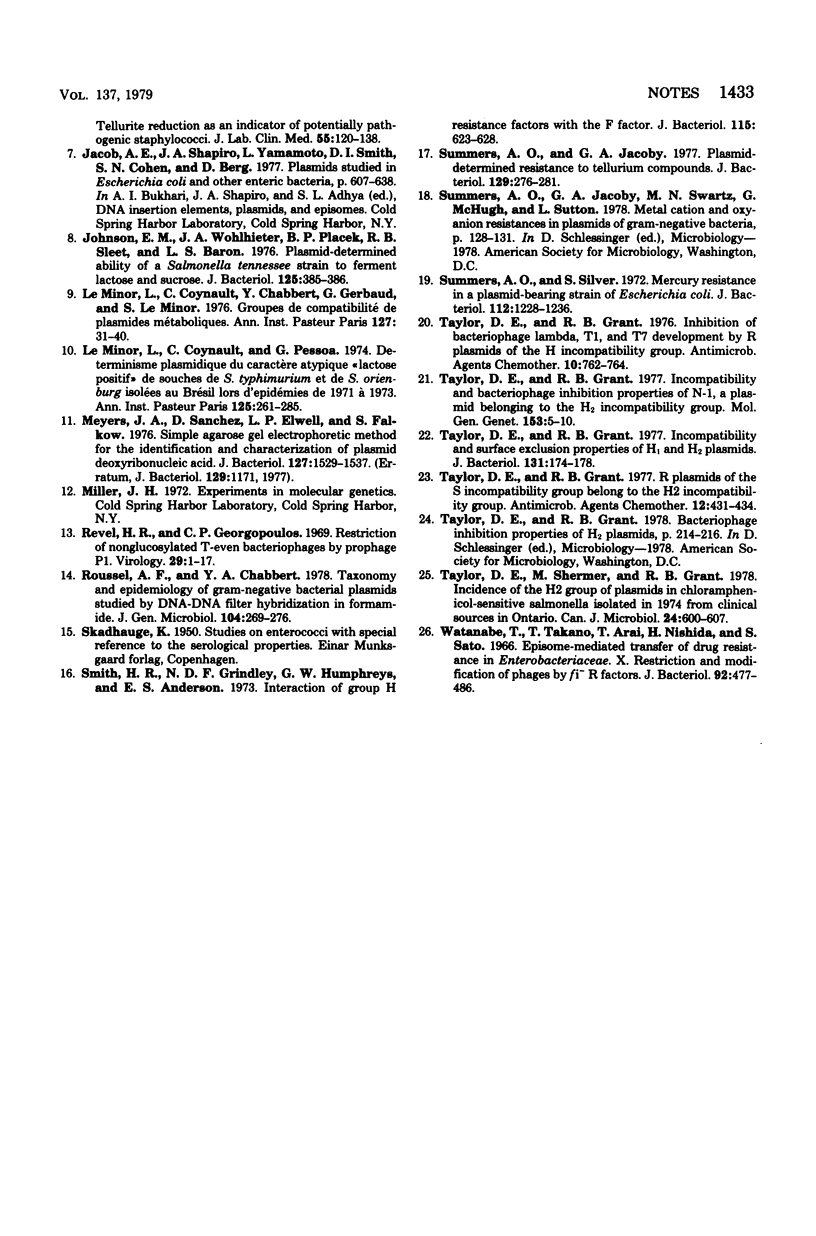Abstract
Concomitant resistance to tellurium compounds (Ter) and inhibition of coli-phage development (Phi) are properties mediated by many H2 incompatibility group R plasmids which have been isolated from diverse bacterial and geographic sources. Ter plasmids from tellurium-resistant bacteria that were isolated from sewage and industrial wastes also mediated phage inhibition. Of these Ter plasmids, three from Citrobacter freundii belonged to the H incompatibility group, whereas three from Klebsiella pneumoniae did not.
Full text
PDF



Images in this article
Selected References
These references are in PubMed. This may not be the complete list of references from this article.
- Grindley N. D., Humphreys G. O., Anderson E. S. Molecular studies of R factor compatibility groups. J Bacteriol. 1973 Jul;115(1):387–398. doi: 10.1128/jb.115.1.387-398.1973. [DOI] [PMC free article] [PubMed] [Google Scholar]
- Grinsted J., Saunders J. R., Ingram L. C., Sykes R. B., Richmond M. H. Properties of a R factor which originated in Pseudomonas aeruginosa 1822. J Bacteriol. 1972 May;110(2):529–537. doi: 10.1128/jb.110.2.529-537.1972. [DOI] [PMC free article] [PubMed] [Google Scholar]
- Hansen J. B., Olsen R. H. Isolation of large bacterial plasmids and characterization of the P2 incompatibility group plasmids pMG1 and pMG5. J Bacteriol. 1978 Jul;135(1):227–238. doi: 10.1128/jb.135.1.227-238.1978. [DOI] [PMC free article] [PubMed] [Google Scholar]
- Hedges R. W., Rodriguez-Lemoine V., Datta N. R factors from Serratia marcescens. J Gen Microbiol. 1975 Jan;86(1):88–92. doi: 10.1099/00221287-86-1-88. [DOI] [PubMed] [Google Scholar]
- Johnson E. M., Wohlhieter J. A., Placek B. P., Sleet R. B., Baron L. S. Plasmid-determined ability of a Salmonella tennessee strain to ferment lactose and sucrose. J Bacteriol. 1976 Jan;125(1):385–386. doi: 10.1128/jb.125.1.385-386.1976. [DOI] [PMC free article] [PubMed] [Google Scholar]
- Le Minor L., Coynault C., Chabbert Y., Gerbaud G., Le Minor S. Groupes de compatibilité de plasmides métaboliques. Ann Microbiol (Paris) 1976 Jul;127(1):31–40. [PubMed] [Google Scholar]
- Le Minor L., Coynault C., Pessoa G. Déterminisme plasmidique du caractère atypique "lactose positif" de souches de S. typhi-murium et de S. oranienburg isolées au Brésil lors d'épidémies de 1971 à 1973. Ann Microbiol (Paris) 1974 Apr;125A(3):261–285. [PubMed] [Google Scholar]
- Meyers J. A., Sanchez D., Elwell L. P., Falkow S. Simple agarose gel electrophoretic method for the identification and characterization of plasmid deoxyribonucleic acid. J Bacteriol. 1976 Sep;127(3):1529–1537. doi: 10.1128/jb.127.3.1529-1537.1976. [DOI] [PMC free article] [PubMed] [Google Scholar]
- Revel H. R., Georgopoulos C. P. Restriction of nonglucosylated T-even bacteriophages by prophage P1. Virology. 1969 Sep;39(1):1–17. doi: 10.1016/0042-6822(69)90343-2. [DOI] [PubMed] [Google Scholar]
- Roussel A. F., Chabbert Y. A. Taxonomy and epidemiology of gram-negative bacterial plasmids studied by DNA-DNA filter hybridization in formamide. J Gen Microbiol. 1978 Feb;104(2):269–276. doi: 10.1099/00221287-104-2-269. [DOI] [PubMed] [Google Scholar]
- Smith H. R., Grindley N. D., Humphreys G. O., Anderson E. S. Interactions of group H resistance factors with the F factor. J Bacteriol. 1973 Aug;115(2):623–628. doi: 10.1128/jb.115.2.623-628.1973. [DOI] [PMC free article] [PubMed] [Google Scholar]
- Summers A. O., Jacoby G. A. Plasmid-determined resistance to tellurium compounds. J Bacteriol. 1977 Jan;129(1):276–281. doi: 10.1128/jb.129.1.276-281.1977. [DOI] [PMC free article] [PubMed] [Google Scholar]
- Summers A. O., Silver S. Mercury resistance in a plasmid-bearing strain of Escherichia coli. J Bacteriol. 1972 Dec;112(3):1228–1236. doi: 10.1128/jb.112.3.1228-1236.1972. [DOI] [PMC free article] [PubMed] [Google Scholar]
- Taylor D. E., Grant R. B. Incompatibility and bacteriophage inhibition properties of N-1, a plasmid belonging to the H2 incompatibility group. Mol Gen Genet. 1977 May 20;153(1):5–10. doi: 10.1007/BF01035990. [DOI] [PubMed] [Google Scholar]
- Taylor D. E., Grant R. B. Incompatibility and surface exclusion properties of H1 and H2 plasmids. J Bacteriol. 1977 Jul;131(1):174–178. doi: 10.1128/jb.131.1.174-178.1977. [DOI] [PMC free article] [PubMed] [Google Scholar]
- Taylor D. E., Grant R. B. Inhibition of bacteriophage lambda, T1, and T7 development by R plasmids of the H incompatibility group. Antimicrob Agents Chemother. 1976 Oct;10(4):762–764. doi: 10.1128/aac.10.4.762. [DOI] [PMC free article] [PubMed] [Google Scholar]
- Taylor D. E., Grant R. B. R plasmids of the S incompatibility group belong to the H2 incompatibility group. Antimicrob Agents Chemother. 1977 Sep;12(3):431–434. doi: 10.1128/aac.12.3.431. [DOI] [PMC free article] [PubMed] [Google Scholar]
- Taylor D. E., Shermier M., Grant R. B. Incidence of the H2 group of plasmids in chloramphenicol-sensitive salmonella isolated in 1974 from clinical sources in Ontario. Can J Microbiol. 1978 May;24(5):600–607. doi: 10.1139/m78-098. [DOI] [PubMed] [Google Scholar]
- Watanabe T., Takano T., Arai T., Nishida H., Sato S. Episome-mediated Transfer of Drug Resistance in Enterobacteriaceae X. Restriction and Modification of Phages by fi R Factors. J Bacteriol. 1966 Aug;92(2):477–486. doi: 10.1128/jb.92.2.477-486.1966. [DOI] [PMC free article] [PubMed] [Google Scholar]



